Apr 07, 2025
Apr 07, 2025
The December 21, 2012 End of the World Prophecy: Part II
In the previous article, the Mayan prophecy predicts the return of Quetzalcoatl at the end of the fourth world and beginning of the fifth world on December 21, 2012.
Quetzalcoatl means the Plumed Serpent and also Precious Twin. He was a bearded white-robe and deified ancestor born of the virgin Coatlicue, the earth goddess. She assigned him to the task of bringing fertility to the earth and agriculture in the form of maize to humanity. As Lord of the Dawn, Quetzalcoatl struggled with Tezcatlipoca or Smoking Mirror, Lord of the Night, in the creation and destruction and rebirth of the Five Suns or worlds. Quetzalcoatl was likened to Ehecatl, the wind and movement god, movement which brings life and death and rebirth. Prophecies related that he would come from the east on a significant calendar date possibly on the raft of serpents he used to travel in the past. He introduced agriculture, writing and is patron of merchants, arts and crafts. His name was used for Mayan priests and rulers to emulate. He demanded the end of human sacrifices and limits on the sacrifice of animals, with occasional offerings of snakes or butterflies. His era, known as the Classic Maya period, saw a reduction of war, if compared to the Aztecs and Toltecs, most notably by the complete absence of Mayan fortified cities. His cities flourished in relative peace, advancing in the arts and expanding a Mayan civilization under common mercantile bonds. Below he is depicted as a merchant bearing a sacred offering to carry through the Underworld:
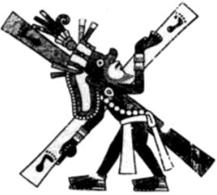
Figure 1
Quetzalcoatl is also called the Great Twin, who is accompanied on his journey through the Underworld by his twin Xolotl wearing a dog mask:

Figure 2
Quetzalcoatl is the Morning Star, Lord of the East, Lord of the Dawn, life and rebirth and Xolotl is the Evening Star, Lord of the West, of the setting sun and of death. Together they travel the Underworld to retrieve the bones of the dead of the former world in order to recreate life in the new world. It is through these world life-cycles that the deities find the time and place to reach down and enter the world of the Maya.
The Maya have a history of predicting significant calendar dates, which each give the people a significant sign of the changing of worlds often associated with an ancestral hero. For example, the Aztec calendar date of One Flower- One Flower - One Reed or Ce Xochitl – Ce Xochitl - Ce Acatal corresponds with April 21, 1519. To clarify, it was the Mayan Long Count Calendar that set future dates with the expectation of significant events and the return of culture heroes. The Aztec Calendar did not set future long counts. However, both Aztec and Mayan priests understood the significance of the prophecies of these future events. As well, the Aztec and Mayan priests had prophesied that on this day the deified ancestor, Quetzalcoatl, the Plumed Serpent, would return with his symbol of the butterfly. When the Mayan priests saw the sails of Cortez’ fleet coming over the horizon like butterfly wings on the very calendar day of One Reed, they knew their world was about to change. Only two years later the Aztec empire would fall at the hand of the Spanish Conquistadors lead by Cortez and within 20 years the Aztec population was decimated by smallpox and the fallout of the colonial war.
Figure 3: The Aztec Xochitl or flower

One Flower was the day ruled by the Aztec deities Xochiquetzal or Flower-Feather, the goddess of new birth, and Huehuecoyotl or Old Coyote, the god of trickery and deceit. It was the same day of the maize god, Centeotl, who corresponds with Quetzalcoatl. Though Cortez was regarded as the return of Quetzalcoatl, he became more the trickster for his role in taking down the Aztec empire.
Figure 4: The Aztec Acatal or reed

Ce Acatal is a name used by the Aztec for Quetzecoatl. In contrast, the Mayan Calendar end-date (see Part I) of December 21, 2012, corresponds with the Aztec day: 4 Xochitl (Flower) - 1 Ollin (Movement) - 1 Calli (House). Again the day Flower is ruled by Flower Feather, the goddess related to new birth. The deity of the 13 day Aztec cycle, called Movement, is Tlazolteotl or Filth Goddess, mother of Centeotl, the maize god. She is responsible for ritual cleansing and the purification of the earth or more specifically she is the consumer of the sins of humanity. The twins Xolotl, the Shapeshifter, and Quetzalcoatl, the Plumed Serpent, are also deities appointed to the Ollin symbol.
The Mayans predicted the coming of Quetzalcoatl to the very day. Is there any way to benefit from the past predictions of these Mesoamericans in relation to the 2012 prophecy? Consider a parallel symbolism expressed mystically in relation to the prophetic Mayan dates using the Aztec day symbols below:
April 21, 1519 – The goddess of rebirth is allotted to one portion (1 flower) of humanity with one event (1 flower) of rebirth under the god of deception (the Mayans benefit from the fall of the Aztec overlords). One Reed is the location of the event (the Aztec city of Tenochtitlan).
December 21, 2012 – The goddess of rebirth is allotted to four portions (4 flowers) of humanity and one event (1 movement and shape shifting?) of purification occurs by the goddess of filth in the location of one house (?).
A prophetic mystic, that is, an interpreter of sacred symbols to help others prepare for possible future events, might interpret these signs to mean the following: A sign of purification will occur by a shape shifting or movement at a convergence of four portions of humanity where a sacred house is located. This occurrence will somehow bring life or be beneficial to those four portions of humanity, yet through a purification. In 1519 the sign of the appearance of Quetzalcoatl (or his trickster twin Cortez) occurred on the exact calendar day and the event took two years to unfold.
The Ollin sign as Movement is depicted as the central design of the Aztec calendar:
Figure 5: The Ollin Movement Sign

In each calendar date, Quetzalcoatl, the deity of maize, is expected to return. In the past it occurred through a Spanish conqueror. Is December 21, 2012 also a day to expect a sign? Is there going to be a purification that will lead to a new birth for all the earth? Will there be another Quetzalcoatl? Who was he or who will he be?
Figure 6: This Aztec calli or house appears much like the temples atop Aztec pyramids.

The symbol of Ollin is depicted below in another form from the Borgonicus Codex, Plate 10:
Figure 7: Ollin Movement variation
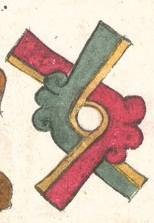
It represents birth (green) and death (red), the beginning and the end, which is likely akin to Morning and Evening Star symbols, the pathway of the hero Twins. This symbol also corresponds with the Cygnus constellation as described in the Introduction above.
When the day sign Four Movement (4 Ollin) is given, it represents Tonatiuh, the Sun of the Fifth Era. This era began at Quetzalcoatl’s patron city, Teotihuacan, where in pure darkness the upper realm was pressed against the earth with no sky to separate them. The hero twins begin to separate earth from sky in the opening of this Fifth World. The separation requires a decapitation of the jaw of the crocodile Cipactli. The body is used as the earth. This crocodile was a constant eater throughout the Aztec deluge, but now becomes a harmless abode for humanity to once again thrive upon. Cipactli is not only the deity representing the earth, but also the bringer of earthquakes.
Cipactli is shown here from the Borgonicus Codex with missing lower jaw and ears of corn growing from her back:
Figure 8: Cipactli – World Crocodile

The Mesoamerican Cipactli is similar to the Makara of ancient Indian mythology shown below:
Figure 9: East-Indian Makara

This Indian and Southeast Asian makara in its aspect as kirtimukha, the Face of Glory, is illustrated below with the great deluge and pearls coming out of his jawless mouth.
Figure 10: Kirtimukha Makara version

The Indian deluge myth relates that the waters of Ganges poured down on the head of Shiva, whose hair caused the waters to form rivers on the earth. Shiva enables the destructive potential of the waters falling upon the earth to become a source of life for all living things. The pearls represent the succession of the new generations and seeds, which will be born onto the new earth and live in harmony with it. Makara or water monster and mukha or face is related to mugger, the Hindi word for crocodile.
Illustrated below is a similar water deity of Mesoamerica, named Chac:
Figure 11: Mayan Chac from Uxmal
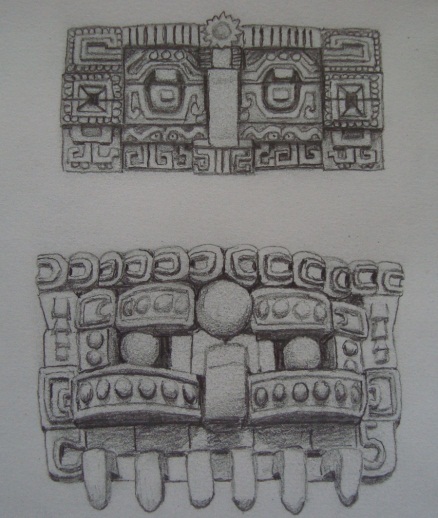
The Mayan Chac, is deity of rain and crops. It is carved here at Uxmal without a lower jaw, remarkably similar to the Face of Glory in India. Chac holds a snake lightning-bolt, which combines fire with his water symbol to mean a sacred war. Chac may occur in four aspects as the old men of the four quarters of the earth, much like the Hopi, with each direction assigned his own color (east is red; north is white; south is yellow; west is black). He has been likened to the Feathered Serpent, Kukulcan (Quetzalcoatl).
The Mayan Chac also has the long nose of the Hindu Makara. The illustrations of Chac below from Chichen Itza and Uxmal so much resemble the Indian elephant that there must have been a sharing of mythology in the ancient past.
Figure 12a-b: Elephant style Chac deity
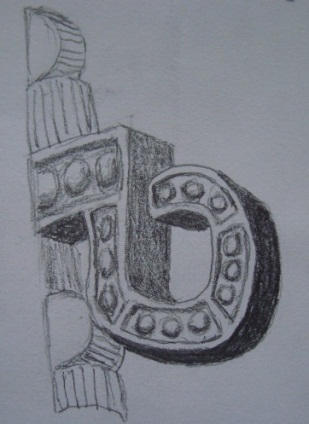
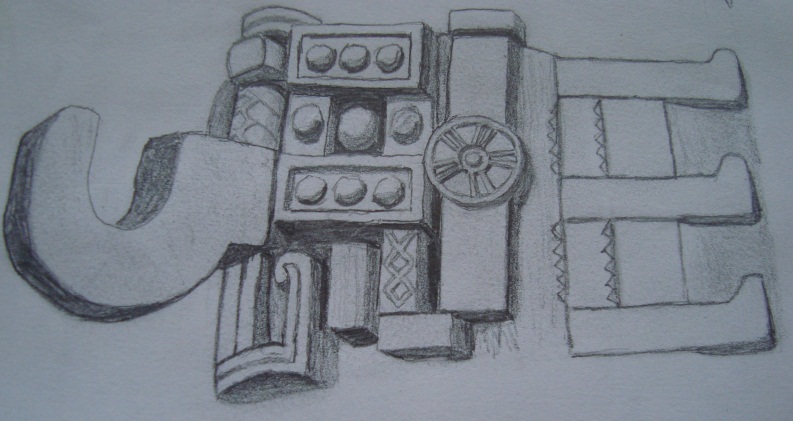
The Chac carvings of Mesoamerica appear to resemble the Indian elephant for the very purpose of leaving an ancient memory of contact between the sages across the continents. The stonework below from the ancient Mayan site of Labna contains the Chac ‘elephant-like trunk’ rearing back with the vision serpent jaws opening to reveal an ancestor.
Figure 13: Chac trunk serpent face variation
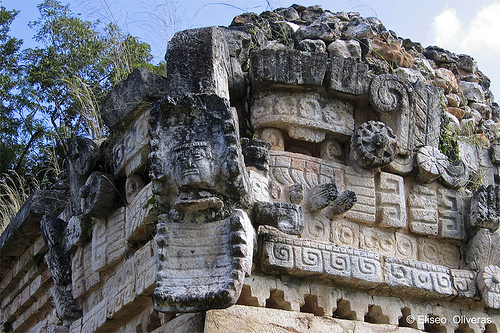
There is a purpose the elder sages of the past used combined a foreign elephant image with a local vision serpents. Modern research would deny any correlation. Yet, any child will tell that these are elephant tusks. First, consider the meaning of vision serpents in Mesoamerican art:
Figure 14a-b: Cloud Serpent of Mesoamerica and India
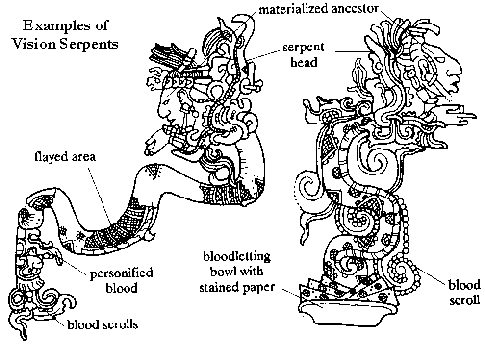
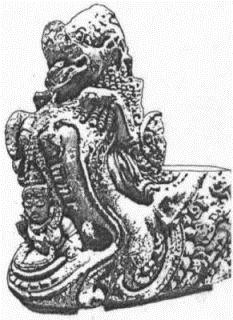
Quetzalcoatl as the bearer of the mask of Chac has an appearance and role similar to the vision serpent. In the Mayan bloodletting ritual, paper stained with the blood of the participant would be burned and the smoke would rise up with the hope of producing a vision. In the vision the smoke would form into a snake with two heads, one for the underworld and one for the earth. As a result an ancestor could travel through the snake from the land of the dead to the land of the living. The snake itself is considered a representation of the Milky Way, the abode of the ancestors.
The Plumed Serpent image makes perfect sense when the Milky Way is regarded as the snake. That is, as the night dissipates into dawn, the snake sheds its skin and the feathers of the quetzal appear as raise of the dawn. The sun rises as the eagle as carved on the drum of Malinalco presented below.
The sacrifice, like that of Quetzalcoatl where he and his twin used the two world trees to raise the sky from their Mother Earth, causes the ancestor to travel from heaven to earth or from the land of the dead to the land of the living. Quetzalcoatl was known to morph from a snake fallen to the underworld in sacrifice into a bird flying to the heavens. Thus, there are the flayed areas of the Vision Serpent and the feathers on the Plumed Serpent. In comparing Xipe Totec, the Flayed Lord of the early spring to Quetzalcoatl, the Plumed Serpent, Inga Clendinnen writes:
In some representations the tendency for the naturalistic snake-skin to break into plumage intensifies until the snake creature is a complex whirl of long feathers…. And then we see the ‘human’ face framed in the open jaws, the ‘human’ hands and feet glimpsed in the shining feather swirl. We are not looking at a man swallowed by a feathered snake, but at Quetzalcoatl, an integrated being in his own plumed skin, the lower jaw of the ‘snake’ his necklace.
Therefore, Quetzalcoatl performs his creator-trickster role using universal images to offer spiritual messages and ceremonies to his people. Who are his people? Just the Mesoamericans? The Milky Way is for all of the earth. Here is where the child questioning the researcher about the reality of seeing the Indian elephant trunk in the Mesoamerican carvings of Chac.
The Child: You want to teach me about ancient Indigenous Americans?
Researcher: Yes! I’ve devoted half of my life to preserving and rebuilding the ancient ruins of Mexico. Look at this picture I took of Chac, the water-monster rain deity?
The Child: He is not a monster, he is just an animal of the water. That is an elephant?
Researcher: No its not! He just has a big nose.
The Child: Why?
The Researcher: We don’t know why.
The Child: I know why, so that he appears like an elephant.
The child and researcher agree to disagree.
Yet, consider the possibility that the ancient Mayan elders chose to represent Chac as an Indian elephant. This possibility exists for the very reason that certain Chac stone works look very much like an Indian elephant. The Scientific Method beckons further study in this regard. Why does the Mayan deity, named Chac, look like an Indian elephant?
The Mayan elders teach of the vision serpent representing the underworld Milky Way. In actuality, when the sun is shining in Mexico, the Milky Way can be seen in the night sky of India. The mythology of the Milky Way as the abode of ancestors is a universal Indigenous concept. Do these common Underworld beliefs help prove an early contact between ancient Indigenous elders from India and Mesoamerica? This question may be the farthest thing from the mind of the modern researcher. But an inquisitive child wants to explore the possibilities.
In the Hindu sacred writing, the Dhammapada, the chapter on the World relates a gift giving ceremony of a king and queen in honor of the Buddha and 500 monks. The purpose of the ceremony is specifically stated for the sharing of the joy or rejoicing in another’s good actions, which is a wholesome virtue inspiring others to undertake good actions themselves. The story continues from the Dhammapada as follows:
Unfortunately, there are only 499 trained elephants; the only others available are rogue (wild) elephants, which might be dangerous to the monks. However, the queen points out that a rogue elephant can be safely employed to attend on Angulimala: one is put in place for this purpose, and in his presence it becomes completely peaceful.
Angulimala was the 500th monk who became a monk after a life of crime. The point of the story is that his restoration by the forgiveness of the Buddha enables an evil deed to be covered by virtuous deeds. The wild elephant recognizes the power (karma) of this active truth (Dharma) in the reformed monk, therefore making the wild elephant appear tame. Such is the elephant trunk rearing up (above Labna photo) to announce the presence of Queztalcoatl born anew in the Mayan warrior receiving the vision serpent.
There is further confirmation of pre-Columbian contact between India and Mesoamerica by the presence of American corn in Indian Temples:
Figure 15a-b: Mayan Corn in Ancient India
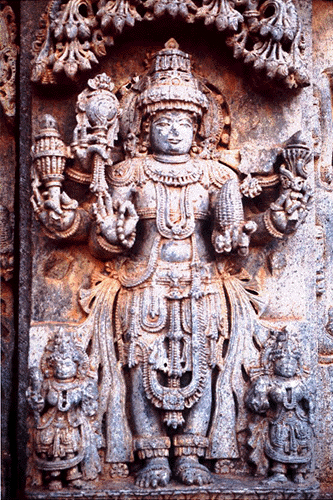
The corn is present in various 12th Century ce temples in the Indian state of Karnataka. Such evidence solidifies the representation of Indian elephants on the stonework of ancient America. Further research into the sea trade and ocean travel capabilities and history of ancient Phoenicia will clarify the means of transport of these trade items and related cultural diffusion. The ship of serpent from Quetzalcoatl’s journey may well have been a Phoenician vessel with serpent like oars as below:
Figure 16: Ship of Serpents
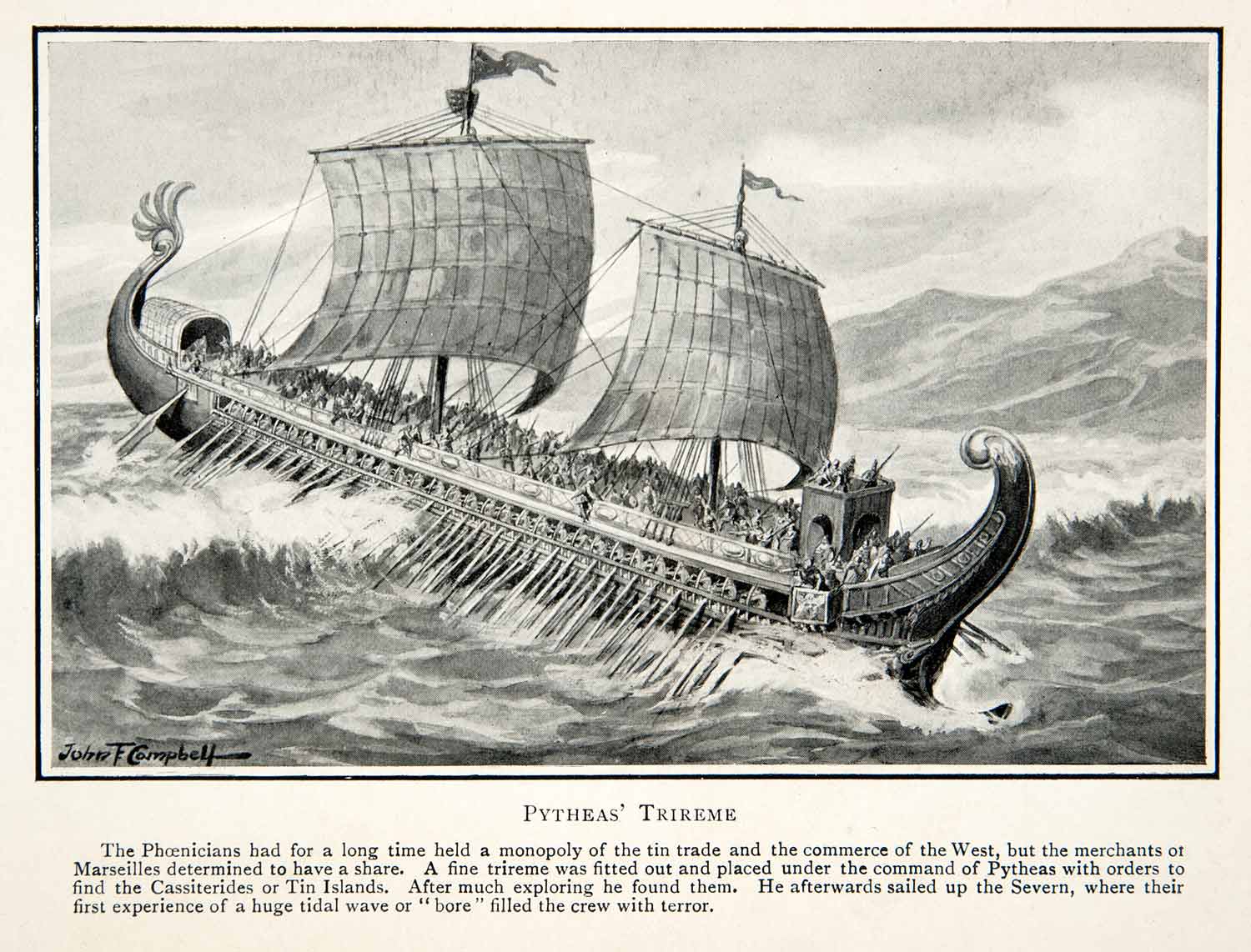
The Mayan word for serpent, coatl, also means a pole. Quetzalcoatl travelled on a ship of poles. He was known as a traveller carrying a staff or even as a butterfly. When Cortez came to Mesoamerica, the sails of his ship were likened to butterfly wings and his appearance as a bearded foreigner with long robes caused the Mayans and Aztecs to believe he was the prophecy fulfilled of the return of Quetzalcoatl.
In ancient India, the story of the Churning of the Ocean also produces a snow-white elephant, named Airavata, in which the deity of war, Indra, adopted as his own, to ride into battle accompanied by a dog. As the churning continued a grey-blue soup of poison rose to the surface. Shiva swallowed it to save the world from the poison and so his throat turned blue. Like Quetzecoatl-Chac of ancient Mexico, Shiva is the blue god of India, also taking on Rudra’s role as storm god.
Figure 17a-b: Blue deity of Maya and India
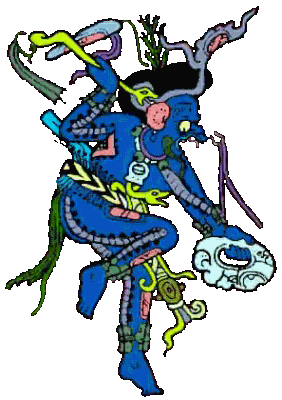
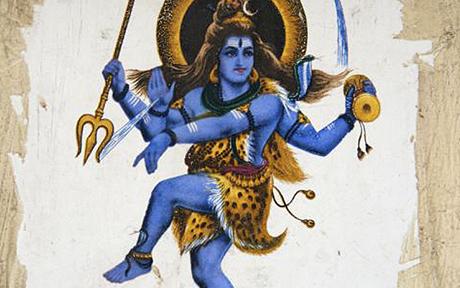
Shiva has four heads to look in every direction for his beautiful wife. He also has a third eye that shoots flames. The snake of the Ganges is forever on his shoulder pouring down its water to give life to the earth, but also used as a weapon during floods and storms. Shiva carries a drum and a lightning trident, not unlike the lightning serpent of Chac. This Hindu vajra lightning appears on the right and the American Hopewell mound serpent head in copper appears on the left below:
Figure 18a-b: Vajra of India and Ancient America
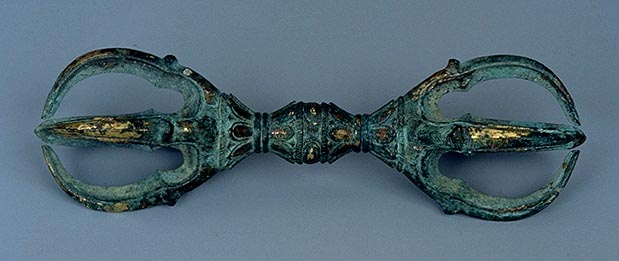
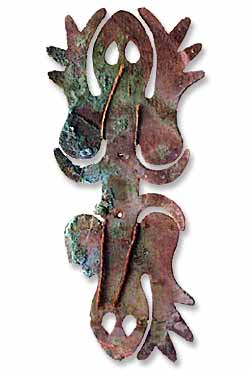
The frog shamanic copper from Hopewell uses the frogs to represent lightning and rain. Hopewell also uses a similar snake copper to represent lightning .
One could compare Shiva to Quetzalcoatl in his role as the deity Chac and see the similarities involving the elements of fire, water, destruction and regeneration of life. Quetzalcoatl also compares with Indra in his journey to retrieve bones of the Underworld accompanied by the dog-masked Xolotl. This Underworld journey is depicted as a sacred war identified by the fire and water symbols of Quetzalcoatl. His jaguar and eagle warriors carry their bloodletting banners as a sign of their vision quest through the Underworld. After facing these pains with tears and blood, their warrior training is complete and they can be adorned with eagle feathers and jaguar skins. Like Quetzalcoatl, Shiva also had a snow-white face and was invoked by those performing penances (even with blood-letting in early India). What is most interesting is the vision serpent story associated with Shiva:
In the Mahabharata, Arjuna, the warrior, invoked him (Shiva) by engaging in austerities until smoke issued from the earth. Then Shiva, ‘the illustrious Hara’, appeared in huge and stalwart form and wrestled with him. Arjuna’s limbs were bruised and he was deprived of his senses. When he recovered he hailed the god, saying: ‘Thou art Shiva in the form of Vishnu and Vishnu in the form of Shiva…. O Hari, O Rudra, I bow to thee. Thou hast a (red) eye on thy forehead…. Thou art the source of universal blessings, the cause of the cause of the Universe…. Thou art worshipped of all the worlds. I worship thee to obtain thy grace…. This combat in which I was engaged with thee (arose) from ignorance…. I seek thy protection. Pardon me all I have done.’ Shiva…embraced Arjuna and said, ‘I have pardoned thee.’
Shiva sometimes wares the skin of an elephant or a leopard. The Indian wild elephant is associated with Vivasvat, the deified sun, who as a shapeless child was rejected but was later carved into the sun to give life to the world. The chips that fell from his body became elephants. Brahma’s incantation helped release Indra’s elephant from a world-egg with other elephants, numbering 16 who went to the 4 directions to support the earth. The Indian Ouroboros (see below), akin to the Quetzalcoatl snake biting its tail, surrounds an elephant standing on a tortoise together supporting the earth. Much like the birth of Queztalcoatl in the Labna carving of Chac with elephant trunk and vision serpent (above), the white elephant of Buddhist China announces the Buddha’s birth. The Chinese deified elephant, Hsiang, carries the sacred jewels of the law, just as Quetzalcoatl the lower jawbone necklace of the world snake. Like Quetzalcoatl’s conch shell necklace, the snakes lower jaw broken off is meant to herald an era of the law of peace.
Perhaps research into these similarities possibility can teach us something more of the prophecy of Quetzalcoatl about to unfold in history.
A few things cause modern research to lean away from exploring these memories of pre-Columbian contact. Modern researchers follow a type of learning based on individualism and the segmentation of the scientific method. No one person is to blame for chopping up our knowledge, it just happens that way. Yet, Indigenous World-view has been forever calling for an understanding of knowledge to be taken as an organic whole.
Humanity is often also unaware of modern biases against history. This bias tends to limit the accomplishments of early societies even going so far as giving credit for advanced technology of early Indigenous cultures to Aliens from outer space. As well, these gaps in historical knowledge are often left unexplored with the expectation that nothing will be found due to remote locations and distant times associated with those cultures. Exploring the harmony of these cultures akin to weaving a patchwork quilt will bring to light more of the history of who Quetzalcoatl was and what story he shared among Indigenous people.
This image below of Quetzalcoatl, the Feathered Serpent, eating his tail is carved in the ancient city of Xochicalco. This self-consumption of the Mayan god represents time as an eternal cycle of life and death and rebirth again.
Figure 19: Quetzalcoatl as Snake Tail Swallower

In Hindu Mythology it was again the destroyer and creator Shiva who out of the Ganges River faced a giant demon snake or water monster who was preparing to consume all living things. In order to save humanity crouching in fear under its coils, Shiva made a far more fearsome snake form out of his third eye. This snake was so ferocious it caused the demon snake to tremble and plead for mercy. Shiva then took the demon snake under his rule, leaving the greater snake to turn its insatiable face toward humanity. To save those paralyzed in fear, Shiva caused the ‘third eye’ snake to forever consume its own tail in order to sustain life on earth. Indian cosmology further tells of the earth created inside this world snake circle supported by elephants and the tortoise:
Figure 20: India Snake Tail Swallower
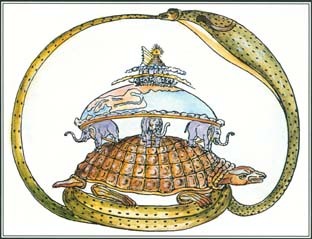
This world snake biting its own tail occurs in the myths of South America, West Africa, as mentioned above with the Hindu and Maya, and as the Ouroboros in Greek mythology. There is a universality of the ancients’ use of this sacrificial snake representing the Creator and the cycle of life on earth. Modern research tends to explain universal mythology as coincidence or derived from common natural elements. For example, the snake is a common animal representing the earth and regeneration in these cultures. The snake has the ability not only to crawl and burrow in the ground, but also to shed its old skin becoming like new again. However, Indigenous World-view would ask why this mythology which occurs everywhere speaks of a snake that swallows its own tail, a quality of the creature never perceived at any time in the natural world. There must be a common bond among Indigenous cultures that is worth exploring further.
Thus exploration of common bonds across Indigenous cultures can be directed toward ancient travelling sages, such as, Quetzalcoatl.
In the Yukatan, Quetzalcoatl, translated in Mayan as Kukulcan, was also known among the Maya as their first priest, called Itzamna. In the Historia Antigua de Yucatan, Itzamna was their instructor and:
gave names to all the rivers and divisions of land; … and taught them proper rights … was the patron of healers and diviners, and had disclosed to them the mysterious virtues of plants …. (he) first invented the characters of letters in which the Maya wrote their numerous books, and which they carved … on the stone …. He also devised the calendar…. Itzamna, regarded as ruler, priest and teacher, was, no doubt, spoken of as an historical personage.
Among the Mayan tribe of the Tzendal, they called him Heart, in their language Votan. Therefore, Votan may be akin to the Popol Vuh’s mythical hero Huracan, meaning ‘Heart of Heaven’ from the Quiche Maya of the Guatemalan Highlands. Votan as a king of the 7th Century c.e. was the founder of Palenque and travelled there past the ‘dwelling of the thirteen snakes’ from his ancestral home of Chivim. Votan and his men were called, Tzequil, meaning petticoats, for their long robes. The 17th Century Nunez de la Vega, Bishop of Chiapas, wrote of an account of Votan from a Tzendal codex (with portions preserved in two secondary sources, the Bishop and Ordonez de Aguilar):
Four times Votan returned to his ancestral home, the land of Chivim. Returning from the first of these voyages he came upon a tower which had been planned to reach the heavens but was destroyed because of a ‘confusion of tongues’ among its builders. Prior to each voyage he divided the country into four districts…. Votan did not die, like ordinary mortals. When his time came he descended through a cave into the underworld and so found his way to ‘the root of heaven’.
Quetzalcoatl, the Plumed Serpent, travel to the Underworld was likened to Votan’s dwelling in a cave. Providing a backdrop for the relationship of Votan to Quetzalcoatl, consider Quetzalcoatl’s prophecy. In this prophecy, Quetzalcoatl is due to return after 13 heavens and 9 hells. The celestial and underworld dwelling amount to time cycles of 52 years each. The end of the 13 heavenly cycles was believed to occur on the 1519 ce arrival of Cortez, the ‘twin trickster’ image of Quetzalcoatl. 13 heaven cycles by 52 years equals 676, back from the arrival of Cortez makes the beginning of the prophecy at 843 ce. 9 hell cycles times 52 years equals 468 years. Ushered by the arrival of Cortez in 1519 ce began the cycle of the 9 hells ending 468 years later on August 16, 1987. Therefore, Votan’s travel past the dwelling of the 13 snakes is related to the 13 heavens of Quetzalcoatl’s return prophecy. After all, snake relates to heaven in the quality to regenerate by shedding skin akin to an eternal life cycle.
Related to this Quetzalcoatl prophecy and time cycle of 13 heavens and 9 hells is the Aztec temple built 100 km from Mexico City called Cuauhcalli, meaning ‘House of the Sun’ or ‘House of the Eagles’. It is also called 9 Calli, meaning 9 house. This temple is the only of its kind in ancient America built from a single stone. The inside of this single stone temple is shown below:
Figure 21: Inside Temple of the Warriors
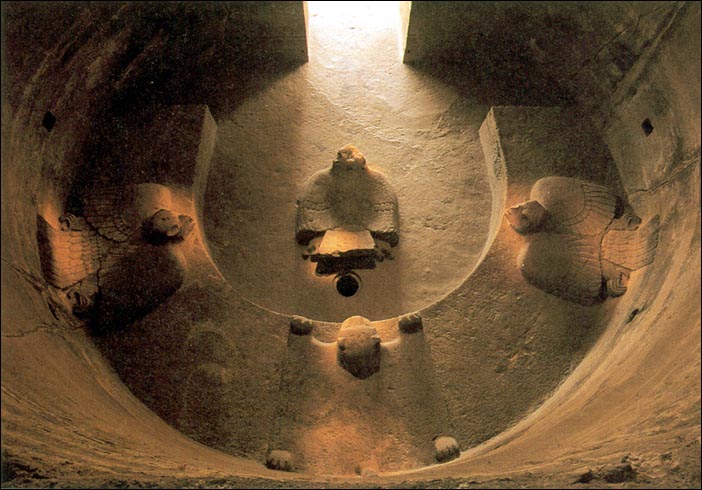
After a rise of 354 steps divided by 13 levels stands the temple with various representations of jaguars and eagles inside. The serpent mouth entrance of the cave opens to two crouching jaguars. There are also eagle and jaguar ceremonial seats, with the remains of an eagle and jaguar warrior wall painting. Within the House of the Sun was the heuheutl, meaning drum:
Figure 22: Drum of the Eagle-Jaguar Warriors
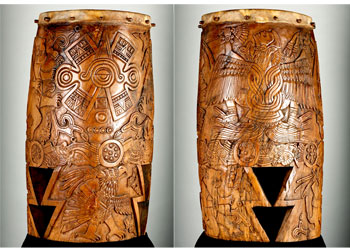
The details of its carving are as follows:
Figure 23: Details of Drum
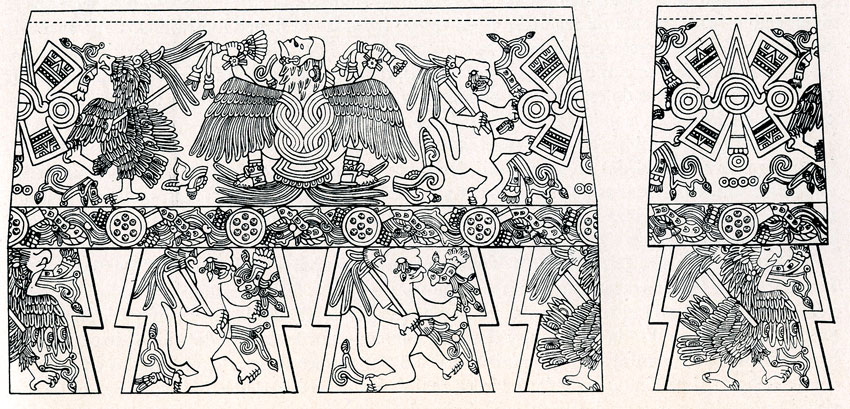
In the upper right is the 4 Movement symbol of the new life of the Fifth Sun. The central figure is morphed into eagle feathered wings and quetzal tail with a face appearing out of the eagles beak. In his hands are the fan and flower, perhaps representing his place as deity of wind and new-life. Song scrolls of poetry fall around him to celebrate his status as arisen warrior. Eagle and jaguar warriors carry sacrificial paper banners in his honor. They dance with speech scrolls that form into water and fire symbols, which combine to mean sacred war. Sacrificial knives are placed in the wings and tails of the eagles. Tears stream from their eyes. It is important to draw out this meaning of sacred war as primarily the battle of the individual soul to be purified by the bloodletting ritual in order to defeat itself and become aligned with the new person fashioned after the character of Queztalcoatl. Out of this sacred war comes a true warrior, fierce as the jaguar and swift as the eagle, ready for battle to protect the people.
Consider the following Izapa stela 67 depicting the rising sun maize god on December 21:
Figure 24: Quetzalcoatl Sacrifice
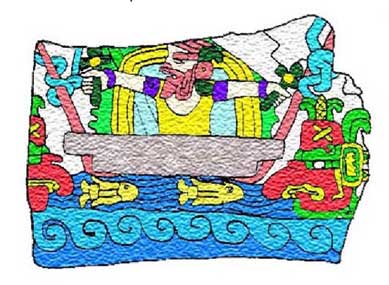
It parallels with Stela 11 of Part I above. A recap of Stela 11 identifies One Hunahpu, lord of the sun regenerating out from the sacrifice at the dark rift of the Milky Way at the constellation of Cygnus, on the December 21 winter solstice. More of this creation story is revealed in Stela 22 of Izapa:
Figure 25: Quetzalcoatl Offering
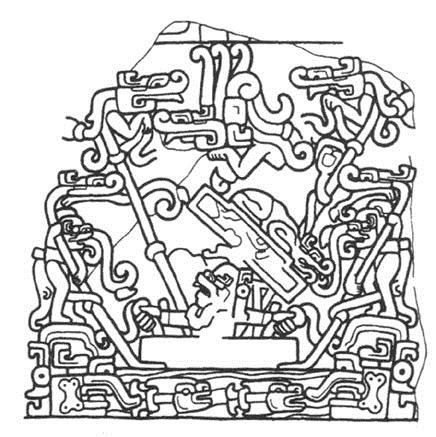
The above image presents the solar maize god in the ball-court canoe, also called One Hunahpu, the father of the hero twins in the creation account. The water below is coupled with the fire from the leaning smoking mirror sacrifice above the head of One Hunahpu. Being sacrificed on the leaning smoking mirror altar is the crouching jaguar. The heat of the sacrifice comes from the solar maize deity’s rays. This water and fire represent the sacred war much like on the 4 Movement Drum above. This warrior of the dawn is also standing in a ball-court and canoe as the victorious ball player. The winner of the ball game is sacrificed, and travels with the ball or the sun across the Milky Way, represented by the canoe, only to rise again at dawn on the other-side. Each Mayan ball-court had a hole in the centre representing the cave in the Milky-Way for the Maize deity to travel through toward the dawn. To hit the ball with the warrior’s hip into one of the two side rings represented the holes where the sun rises and sets. The symbolism kept the game sacred enabling the player to strive for the goal of reaching the dawn of the Plumed-serpent, akin to achieving enlightenment and the soul’s own purification. On either side of Hun Hunahpu are his hero twin sons, Hunahpu and Xbalanque, who as ball players succeed through various sacrificial rituals to pass through and defeat the deities of Xibalba, the underworld. This scene is also depicted on this birth of the Maize god on the Uaxactum Plate illustrated below:
Figure 26: Maize God born out of World-Turtle
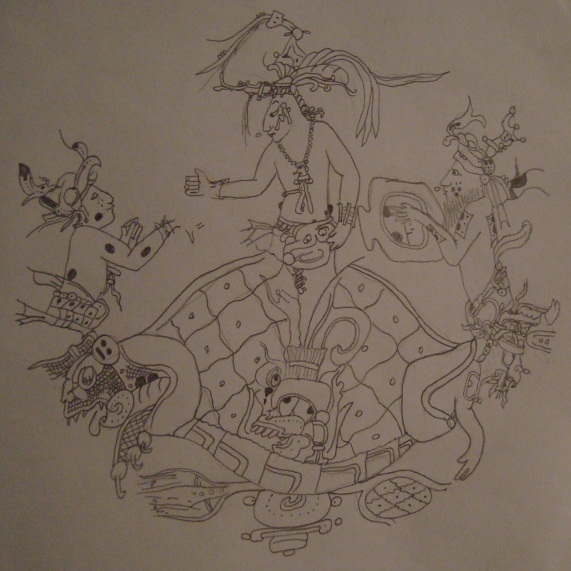
Similarities between this plate from the Mayan lowlands of Guatemala and the following Hindu Churning of the Ocean carving in Southeast Asian’s Angkor Wat can be made:
Figure 27: Churning of the Ocean upon World-Turtle
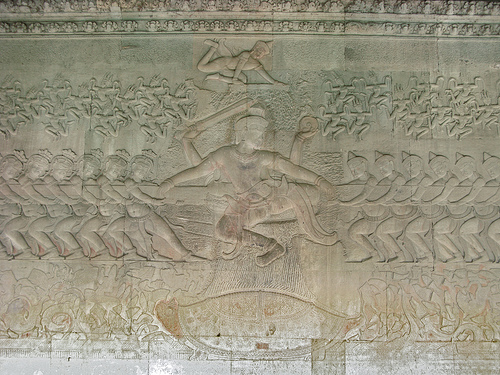
It would be a stretch to say the Hindu Churning of the Ocean is paralleled in Mesoamerican art if it were not for the following three pictures: (from the Mayan Tro-Cortesianus Codex, the Veracruz Ball-Court stone carving and the Aztec Selden Codex respectively)
Figure 28: Mayan Churning of the Ocean 1
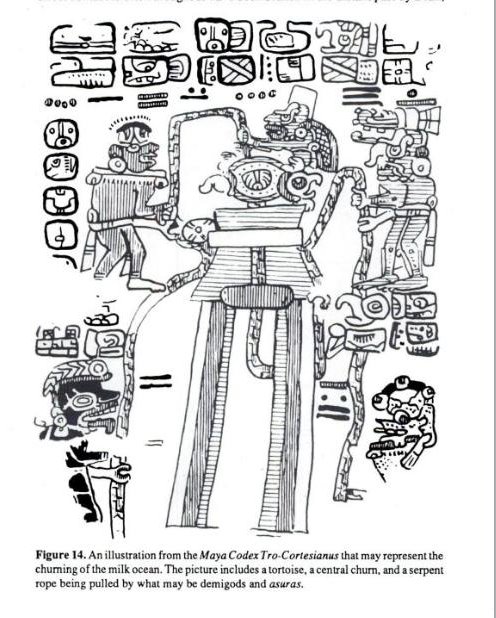
Visible in the codex image above are certain minor deities pulling the churning serpent much like in ancient India. There is also a churning machine below the turtle.
Figure 29: Mayan Churning of the Ocean 2
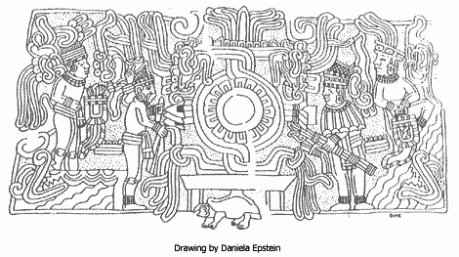
On the above ball-court stela, the turtle below the image of the ball-court canoe produces a solar image overlaying the arrows of sacrifice.
Figure 30: Mayan Churning of the Ocean 3
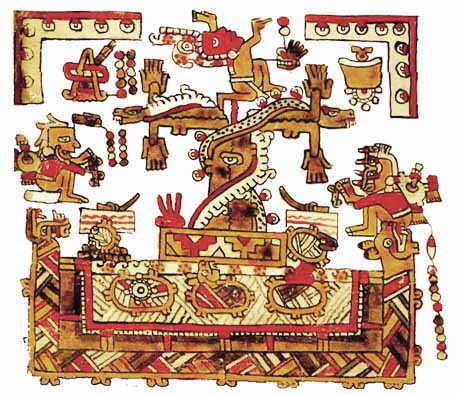
The world tree is used as the pillar of churning from Indian mythology on the above Aztec codex. The solar deity is born out of the centre of the world tree twisted by snakes.
One needs no sudden sign to appear on December 12, 2012, for a fulfillment of the long count prophecies. Just look at the Churning of the Ocean, with the grey poisonous soup rising out of the ocean:
Figure 31: Actual Grey Poisonous Churning of the Ocean

The World-Tree at the centre of the Churning of the Ocean represents the ancestral line of humanity in relation to all life on earth, together with our spiritual relationship with Mother Earth. The story of Hunahpu is one opportunity to listen to ancestral Indigenous sages and their advice regarding this great churning of human experience on earth.
Figure 32: World-Tree Celestial-Bird Hunt
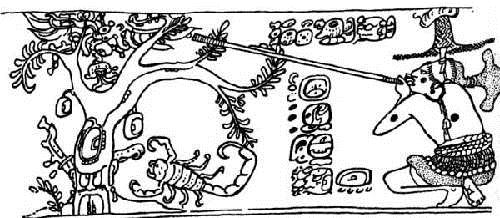
The image reads:
Done by Hun-Ahau on 1-Ahau 3-Kankin he entered the sky, Itzam-Yeh
From the above Popol Vuh creation scene the bird deity 7 Macaw (Vucub Caquix) rests on the world tree after the great deluge. According to the date listed this scene occurs 32 years before the end of the last Fifth-Sun Cycle (3148 bce). The hero twin Hunahpa uses his blow gun to bring down 7 Macaw. The solar bird deity loses its jaw as it falls to its death much like the crocodile above as this tree’s very root is the lower jaw of the crocodile. This falling of the Celestial Solar Bird occurs much like the Cygnus constellation in the Great Rift of the Milky Way. The Stela 2 of Izapa below depicts the hero twins running to benefit from the sacrifice of 7 Macaw:
Figure 33: Quetzalcoatl Celestial-Bird Fall
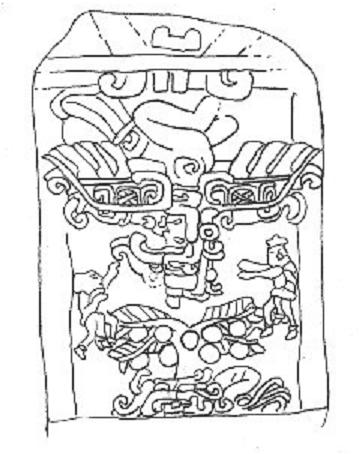
Essentially, the World Tree of Life that the hero twins run toward is now open for humanity to freely pick its life giving fruits. The sacrifice of the Solar bird happens before our world began, so that anyone in our world can receive the fruit of enlightenment. Below in this Olmec Stela the World Tree is the Milky Way crocodile with Hunahpu actually supporting the Celestial Bird recalling that they share the same sacrifice of death and rising at dusk and dawn.
Figure 34: World-Tree Crocodile Celestial-Bird of December 21, 2012
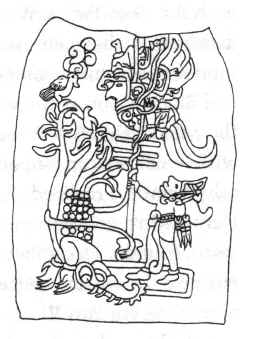
The falling of Seven Macaw or Cygnus the Swan relates to the Hopi prophecy of the return of Massau and the emergence of the Fifth World.
It will come when the Saquasohuh (Blue Star) Kachina dances in the plaza and removes his mask. He represents a blue star, far off and yet invisible, which will make its appearance soon.
The Blue Star of the Plaza in the night sky is the star, called Deneb, the blue star of the constellation Cygnus in the plaza of the Great Rift. This star is at the centre of the December 12th, 2012 ‘dance’ of the Galactic Alignment between the Milky Way and the Sun which occurs every 26000 years.
Figure 35a-b: Nasa’s Great Rift or Dark Rift Image
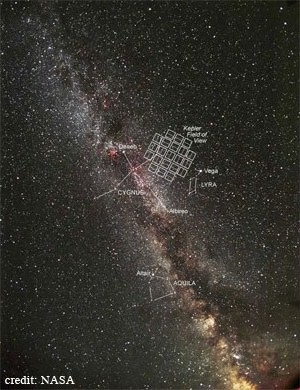
The Blue Star, Deneb, The Mayan call this celestial crossroads the Great Tree or World-Tree, consisting of the Black Road (Xibalba) as the Milky Way and the Red Road as the Path of the Sun. The Sun represents the Creator and the Milky Way the ancestors. In terms of the Mesoamerican mythical significance, the Sacrifice of the Sun at this point causes the purification of the Milky Way and the earth. As discussed above, Quetzalcoatl is the offering made at the World-Tree to purify humanity. The Chichen-Itza Maya erected a central pillar in Can-Ek’s palace, called Yax-Cheel-Cab, ‘First Tree of the World’. At the western base of the World-Tree pillar was carved the mask, called Ah-Cocah-Mut. Mut means both bird and prophecy. It is the celestial bird of Seven Macah atop the Wacah Chan Tree of the Classic Maya. The mask represents death itself as illustrated in the growth of the maize corn plant on the Guatemalan bowl World-Turtle of the Maize God:
Figure 36a-b: Taking off of the Mask blue seed of Maize
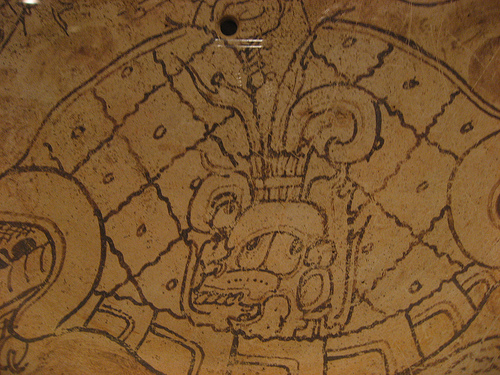
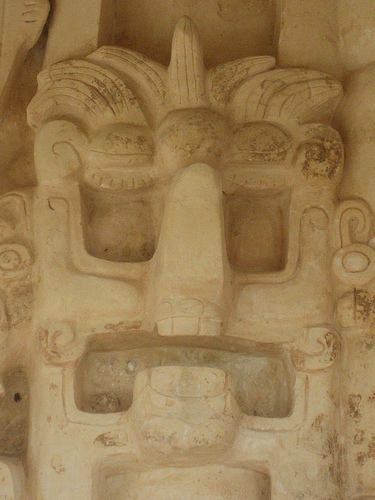
The Turtle-Twins emerge from the broken World-Turtle to water the dead seed represented by the skull mask in the lower centre of the turtle. Out of that seed the Maize God is born as their father who represents for the twins the living ancestral line. Beside the turtle above is a similar representation at Ek Baalam of the seed mask where the maize is sprouting.
The Hopi Blue Star Kachina taking off his mask and dancing in the plaza draws its meaning from the Mayan Maize God imagery. The Hopi were guided to live in their Fifth World after rising out of the Fourth World to the South. That covering of the fourth world occurred at Teotihuacan where early excavation required the removal of five feet of earth from entire plazas, streets and pyramids. The city was falling to invaders, so the inhabitants fled after burying their most sacred ruins. The Hopi were given their tablets by the Massau and the Elder White-Robed brother with instructions to recall the stonework from their former homeland. The research leads to a journey with a community of maize growers who left Teotihuacan with their Lord Quetzalcoatl who gave them tablets and a prophetic message of his return on the end of their homelands Long Count Calendar. The Plaza where the Blue Stone Kachina will remove his mask is at Teotihuacan and he will remove that mask on December 21, 2012.
Consider the diagram below:
Figure 37: Teotihuacan on December 21: 2012
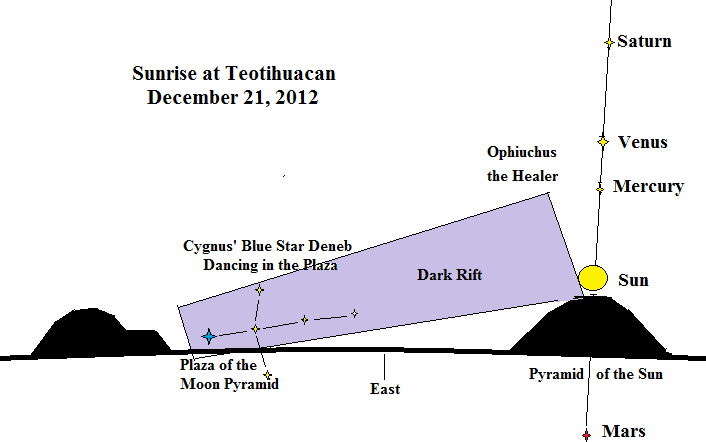
This diagram illustrates the rising of the Sun above the Temple of the Sun at Teotihuacan on December 21, 2012. In the diagram there are Saturn (between Virgo and Lybra), Venus and Mercury (between Ophiuschus and Scorpio) ushering the Dawn. The Dawn is immediately followed by Pluto and Sagittarius. The Healer, Ophiuchus, stands at the entrance of the Great Rift or Dark Rift. Fallen into the Dark Rift is Cygnus the Swan. Rising in early morning is the Blue Star, Deneb, dancing in the Plaza of the Moon Pyramid. Mars rises mid-morning between Sagittarius and Capricorn, followed by Neptune at noon. In the early afternoon, Uranus and the Moon rise out of the Plaza of the Moon with Pisces. Then the Pleiades and Jupiter rise in the evening with Taurus.
A study of world cosmology can be drawn out of this representation. For the purposes of this research a brief description will be given. The Sun represents enlightenment, purification, rebirth and resurrection. The Morning Star(s), hidden in the light of the Sun are those who are enlightened preparing for, sharing and living out the significance of this event. The Event is the Dawn of the Fifth World and end of the Fourth World. The sign of this event for the Hopi based on the decipherment of the four tablets in the introduction above, is the rising of Deneb, the Blue Star, in the Plaza of the Moon when the Sun appears over the Pyramid of the Sun on December 21, 2012.
The imagery of the Dark Rift represents the cave of death where the Sacrifice of Quetzalcoatl (see above Stelas) took place at the end of the Second World (see Hopi Tablets interpretation in the Introduction). The rebirth of Quetzalcoatl was celebrated in the offering of the first fruit (fish and maize). The establishment of a purified earth because of this offering is signalled on December 21, 2012.
In the above diagram, the point of view approaches the city from the West. The Prophecy of this Mask Removing Ceremony is about rebirth, therefore, even the viewpoint from the West, which represents death, is significant to this illustration. The Sun setting the night before in the West represents this death and now its rising represents new life. Yet, on this particular day, called the Galactic Alignment, which happens once every 26000 years, a number of celestial phenomenon fit together like a puzzle revealing volumes of lost ancient wisdom.
The Sun rises on December 21, 2012 at the entrance of the Milky Way’s Dark Rift or Great Rift. This Dark Rift may be represented by a cave or the Crocodile Jaw from the above World-Tree representations. This is the final event on the Long Calendar and is carved on various altars and stonework of the ancient Maya. Consider the following Olmec altar:
Figure 38: Dark Rift Altar 1
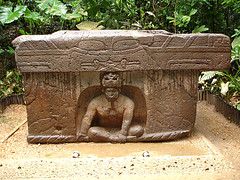
Out of a cave comes an eagle masked priest holding ropes that bind another person. Above the priest is carved the face of the jaguar where the mouth becomes the cave itself. In the mouth is the cross-roads glyph found above to also represent the Cygnus Constellation. Ropes are used in Mayan Codices to represent the stars joined together in constellations. The cave is the Dark Rift and the bound person is the Sun brought to that moment and place at the end of the Long Count Calendar. The eagle and the jaguar represent the sacred warriors participating in the event.
Another representation of the Dark Rift cave is given on Altar 5 at La Venta of the Olmecs:
Figure 39: Dark Rift Altar 2
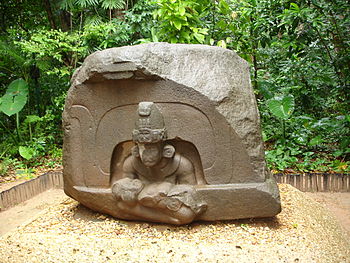
In the arms of the priest whose mask of budding corn is coming off, lies Were-Jaguar Child. The Jaguar who lived in caves is represented in Teotihuacan as a netted jaguar or with a twisted rope between its eyes. The Maya often depict him as the fierce deity of the Underworld Sun and of human sacrifice. The netted jaguar represents the noosed Sun at the conjunction of Cygnus (twisted rope) and other sky events at the end of the Long Count Calendar. The Child-Jaguar on this altar stone has been misrepresented as a child sacrifice. Around the edges of the altar a growing infant jaguar is also represented. The imagery tells of the birth of the Underworld Lord of the Sun as a human being.
Cygnus can be likened to the Mayan World-tree, though fallen has a significant resting place in the Plaza of the Moon. It also represents the headless man on the Hopi Tablets. That may be likened to the sacrifice of the ‘head’ or Lord Queztalcoatl. That head or mask is the Blue Stone, Deneb, dancing in the plaza. Like the seed that dried up and falls away and a new plant is born, the head has fallen but gives rise to a New Man. Death is like a mere mask to this God. He takes off the Mask to reveal his Blue Living Body. This proves that he swallowed the poison of human impurities and corruptibility, but lived to tell the story. Out of this imagery a New World-Tree is born surrounded by a New Population ready to honor the still small voice of Lord Quetzalcoatl, speaking of a remarkable sign in the heavens rising above the pyramids of an abandoned city.
Perhaps this World Tree is nowhere so remarkably carved as on the tomb cover of Lord Pacal, King of Palenque of the 8th Century ce:
Figure 40: World-Tree grace marker of Lord Pacal
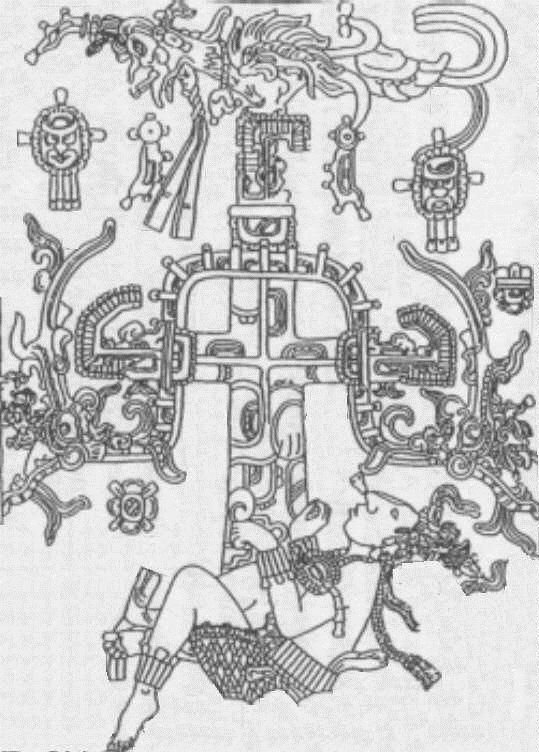
The Celestial Bird rests above, the vision serpents to the left and right and the deceased Pacal raising from his sacrificial sleep of death on the lower part of the carving. Pacal’s location below the world tree as a deified sacrifice is confirmed on the Tablet of the Cross. In Palanque, this Tablet of the Cross describes the birth of the first father, Wacah Chan (called God I of Palenque or GI) before this world began (3122 bce). Wacah Chan means Six Sky or Raised Up Sky. Our world began on 13 Baktun (3114 bce). He dedicated the World Tree House of the North of Wacah Chan on 3112 bce. His son, also called Wacah Chan (GI), was born on October 21, 2360 bce. The late dates add legitimacy to the royal lineage of Lord Pacal and invite the ancestral realm to reside in Palenque. This devotion to the ancestors enables the living to become enlightened, which is the essential result of Wacah Chan raising up the sky. The living also receive protection and fertility from these gods and the dead receive speedy transport through the Underworld.
The Tablet of the Cross with the World Tree and The Foliated Cross both from Palenque are depicted below:
Figure 41: World-Tree grace stones
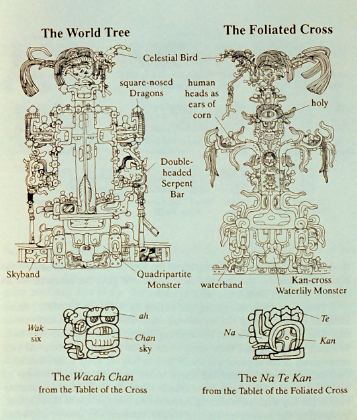
The Foliated Cross describes the second deity, Na Te Kan (GII) as being born November 8, 2360 bce.
The Tablet of the Sun reveals that deity GIII (Mah Kina ? Cab) was born on October 25, 2360 bce.
Figure 42: World-Sun Offering Bundle grave stone
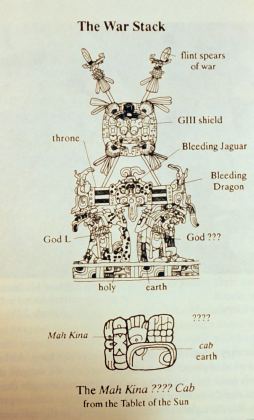
The deity beside God L, written God ??? may be God Chac due to the appearance of the Upper Jaw head-dress. If so, then these support gods are also the hero twins.
The imagery represents the Mesoamerican deified sacrifice, which cleanses the waters first ocean, harnesses the rays of the sun, establishes a seed on the earth for the growth of the World Tree. From this World Tree the sacred Corn or fruit of life is born. The people are given access to this tree of life through the local king whose ancestors represent the tree. To fully participate, the warrior must also sacrifice his or her own blood, sweat and tears. The blood comes by way of blood-letting ceremony, the sweat by personal trade related to the ceremony (such as growing corn, playing an instrument, carving or writing sacred text, being a warrior, etc.) and the tears come with the ceremonial song.
In the Buddhist’s Dhammapada: 222, there is a story of a monk and a tree:
A monk begins to cut down a tree to build himself a hut. The deity living within the tree tries to stop him, holding up her baby in front of the monk. The monk does not see the baby, and cuts off its arm. The deity is tempted to kill the monk, but restrains her anger, and instead goes and reports to the Buddha what has happened. The Buddha speaks the verse in praise of self-restraint, and the deity attains Stream-Entry; however, she still grieves for the loss of her home. The Buddha points to another tree to be the deity’s home: because it is the Buddha’s gift, no one will be able to damage or remove it. The Buddha makes the Vinaya rule preventing monks from cutting down trees.
There is a hidden meaning here that the tree home provided by the Buddha that no one can remove is actually the World-Tree. Another striking parallel from across the ocean, during the Mayan struggle of the Hero Twins to rule this tree, the child Hunahpu’s arm is cut off just as the child in the Indian tree myth above. Notice the Nasa photo of the Dark Rift, where a small grid is made over the arm of the Cygnus constellation. The Kepler telescope is scanning that region for earth like planets outside our solar system. Maybe there is a message here, but don’t start reading all the crop circles just yet. How come crop circles keep getting more and more refined? Are the aliens getting better at making them? Seriously, Quetzalcoatl is one of us and has a Divine Message designed for us.
Quetzalcoatl’s name as Plumed Serpent occurs also among the North West-Coast Salish, as Quaaqua, and the Tlingit, as Yetl. The Zuni language named him, Kaloowise and the Hopi called him, Palulukon (Wuwuchim). Based on the description of Quetzalcoatl as a travelling white-robed healer and sage, various derivatives of Ehecatl, Lord of the Wind, and Huitzilopochtli, Lord of the House of Dawn, are also attributed to Quetzalcoatl. The Puan of the Georgia region called him, Eseecowah, also meaning Wind and Water Lord. Those as far north as the Algonquin called him, Chee-zoos, God of the Dawn Light.
Figure 43: Hebrews in America?
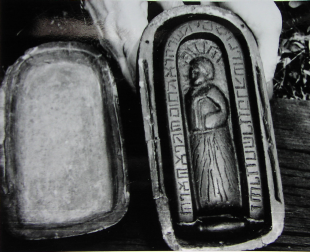
The above photo depicts this same White Robed sage carved on the Newark, Ohio Decalogue Stone found beneath the grave of an ancient Native American priest. The stone contains carvings of the Ten Commandments in ancient Phoenician /Hebrew Script. The Kalispel and Flatheads of the Montana region expected the return of their bearded white-robed sage whom they called, Shining Shirt. Their ancient myths and stories of Shining Shirt were complemented by a vision of a dying 12 year-old Kalispel girl in the late 1800s. She saw a woman who called herself Mary with a child enter the door of her teepee. Is this the Were-Jaguar Baby the Olmec carved on their altars? The decision of the majority of Mayans to follow the message of Our Lady of Guadeloupe points to the answer. More study in this regard is provided by Wikipedia.
All these symbols considered offer a continuity of beliefs in the after-life, which bound Mesoamerican eras, peoples and cultures together. Much of this spiritual bond can be credited to Quetzalcoatl and his ever-present influence throughout the region. Consider this Nahuatl song from one of his major cities:
And they called it Teotihucan
Because it was the place where the lords were buried
Thus they said, ‘When we die, truly we die not,
Because we will live, we will rise,
We will continue living, we will awaken: This will make us happy.’
Thus the dead one was directed when he died:
'Awaken, already the sky is rosy, already the dawn has come,
Already sing the flame colored guans, the fire colored swallows,
Already the Butterflies fly.’
Thus the old ones said that who has died has become a god,
They said: ‘He had been made a god there,’ meaning, ‘He has died.”
The Hopi mythology also corresponds with this sacred city of Teotihuacan. To the Mayan, Teotihuacan was covered with no sky at the beginning of the Fifth World. To the Hopi, the Fifth World consists of a digging out of the ground of the Forth World and rising up on the web of Grandmother Spider to the Fifth as described above with a literal burying of Teotihuacan in five feet of earth. This protective covering over Teoticuacan, the Sacred City of the Fifth World, provides a powerful image of the mission of Quetzalcoatl, the Plumed Serpent, on December 21, 2012, the birth of the Fifth World of the Hopi. Those who are born through this event, by imitating the sacrifices and shedding of old skin of Quetzalcoatl, will be protected by the covering of Mother Earth.
11-Dec-2012
More by : Anonymousfor JoshuaMessiah

|
These things all relate to the site I found in the Superstition Mountains in Arizona. It is the site of the Hieroglyphic the Jesuits used for the locator of the Mina Virgon de Gaudalupe. The site may be viewed on Treasurenet.com under member hunts as Survey of the Mina Virgon. Please take a look at my post. I would like the use of your material in my post. |

|
I'm pretty sure that I am in fact,Quetzalcoatl. I'll be 40 in a few years,I live on the poverty line and I could use some help. |